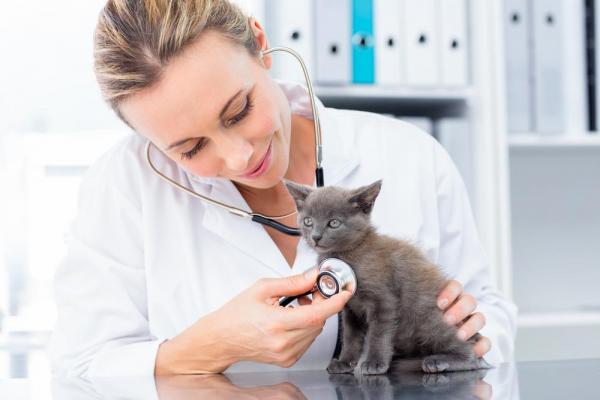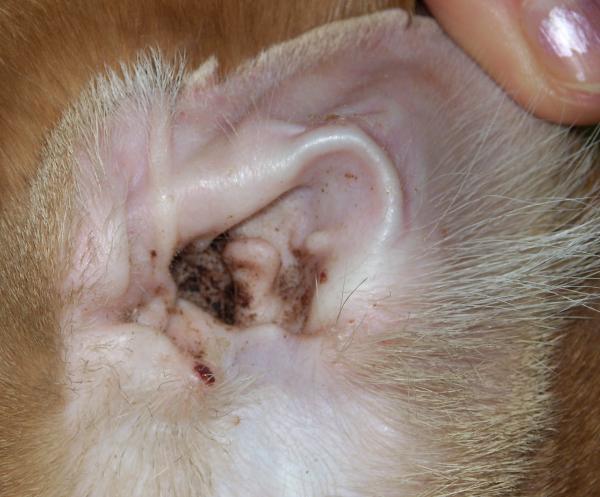Mites in cats – Symptoms, treatment and infection

Parasites, both external and internal, are one of the main enemies of the welfare and health of our pets in general. But if we stop to think about how annoying it must be to have tiny beings proliferating in our ears or skin, we can understand how important it is to know as much as possible about the mites in cats, their symptoms, treatment and infection.
For this, it offers this content as a general guide, to prevent this annoying infestation, or to stop it if it is already present in our pussycat.
The most common mite: Otodectes cynotis
This mite (a species of tiny spiders that seem to have the gift of ubiquity, since they are adapted to all possible environments), lives in the ear of dogs and cats, but it may be along with pulicosis, the most commonly diagnosed external parasitosis in cats. Its life cycle is about three weeks:
- The eggs hatch after about 4 days in the ear canal.
- The larva that comes out feeds and begins to pass through several nymphal stages.
- Finally, at the 21 days of hatching, we have an adult ready to reproduce and perpetuate the infestation.
They live about 8 weeks, but they are well used for an intense reproduction.
Its color is whitish, and the females reach twice the size of the males, but in no case exceed the 0,5 mm. However, we can not classify them as microscopic, because having a collaborative cat and good eyesight, can be observed with relative ease by using the otoscope.
Although its habitat is the ear canal, in severe infestations it can spread to a wider area of the skin of the ear. head and face of our cat, and sometimes it is possible to detect some specimen lost by other areas of the body, being its finding usually anecdotal in those areas. Especially appears in the upper zone of the tail, by the habit of sleeping curled cats have.
It feeds on the outer surface of the skin of the ear canal (it does not dig galleries) and its saliva gives rise to irritation and itching, causing hypersecretion of the glands of the same.

Symptoms of Otodectes cynotis
Otodectes cynotis It is one of the main causes of otitis externa in cats, especially in young specimens. The symptoms are easily recognizable and there does not have to be a massive infestation to see that our cat manifests them. In addition, they can occur cases of hypersensitivity to these parasites (as happens with fleas). The most frequent and characteristic are:
- Dry exudate brownish-yellowish or blackish, compared to coffee grounds or char. Under normal conditions, the inside of our cat’s ears should be pink and free of any exudate. However, if time passes and there is no remedy, there may be secondary contamination with bacteria or fungi, thereby varying the appearance and color of the secretion.
- Intense itching and frequent head shaking. Scratch injuries soon appear, being frequent on the back of the ears, on the cheeks, even in the neck (as when humans suffer otitis and notice an itching sensation in the throat). Erythema and secondary crusting may also appear on the cheeks and the upper part of the eyes.
- Otohematomas. Sometimes marked pruritus, results in the scratching ends by breaking the vessels and capillaries of the atrial cartilage, causing the accumulation of blood. The ear acquires the typical look of a dumpling. If there is no remedy with drains, a clot forms that later becomes fibrous, leaving a “wrinkled ear”.
- Fibrosis and stenosis of the auditory canal. If we do not treat the chronicity of the infestation can cause a thickening of the walls and, consequently, a reduction of the channel light, which can become irreversible as in any otitis.
All these symptoms do not always appear, and as mentioned, there is not always a correlation between the degree of parasitization and the intensity of the symptoms.
Diagnosis of mites in cats
Because it is one of the parasitosis more frequent In cats, our veterinarian will perform an examination of the ear canal at each visit, being able to see this mite with the naked eye if it has enough time and our cat is calm. They usually introduce the otoscope without light, illuminating once inside, to catch the intruder by surprise, and not having time to hide in the secretions.
However, if secretions appear and mites are not detected, it will take some samples with a swab and in the microscope you can observe both eggs, as hexapod larvae (3 pairs of legs), adults (with 4 pairs of legs). Sometimes a drop of oil is used in order to lubricate the secretions, quite dry, and facilitate the exit of these arthropods from the hiding place.
Although there are no intense secretions, or are not revealed in a first review, if we continue noticing compatible discomfort in our cat, our veterinarian will insist on finding isolated specimens that may be causing a hypersensitivity reaction.
The fact of not being seen in a first revision, does not mean that they are not, and that is why it is very important explore the ear in each visit, especially in the first months of life of our cat.

Treatment of Otodectes cynotis
Addition acaricide treatments, it is vital to cleanse the secretions with a suitable cleanser, at least twice a week at the beginning. These cleaners They are usually oily, so they can help rid the parasites mechanically (chokes them), an extra antiparasitic aid that we should apply to our cat.
A small drawback is the accidental entry into the eye of some drop of these cleaning oils, so it is advisable to be very cautious and also the possible appearance of a Horner syndrome, secondary to a cleaning. However, it is rare, and the benefits of cleaning outweigh the disadvantages.
Acaricides plus employees
- Topical selamectin (pipette): Because mites feed on blood and lymph, any product that passes into the cat’s blood will be absorbed by them. The selamectin applied to the skin of the neck, is absorbed by blood capillaries, and reaches optimal concentrations in a few hours, or at most, two days. Mites die when feeding. One dose may be sufficient, but it is recommended to repeat after 3 weeks (the estimated mite cycle time).
- Otic Ivermectin: There are gels with ivermectin, designed to combine the oily power of a cleanser with the acaricidal power of ivermectin. They apply every 7 days, for several weeks but their effectiveness depends on how manageable our cat is and the depth at which we can introduce the cannula. All products can cause reactions in animals and people, but ivermectin, being one of the most used and studied, may have more data on known hypersensitivities. So although it is very safe and effective, we must be alert to any possible side effects (depression, intense salivation, eye problems, difference in the size of the pupils.)
If there is a fungal infection or bacterial secondary, it must be treated with specific products. There are otic suspensions that combine antifungals and antibiotics. Sometimes they trust that they have acaricidal power but it is not like that. Its effect against mites resides in the ability to drown them. But it is a sometimes short treatment and can survive some, so the use of a selamectin pipette is necessary, combined with the treatment of the infection.
Otodectes cynotis infection
El intimate and direct contact It is the way of contagion. We have all wondered how it is possible that our kitten, with just two months, has mites. Probably their mother suffered them and, in the breeding, she has transmitted them to the whole litter. During that time there is a close contact between kittens and mother, with continuous toilet included and mites, like lice in children, soon reach the ears of all cats.
Although they can survive outside the auditory canal until 10 days, the infection by fomites (objects such as blankets, etc.), is very unlikely, although it is not ruled out. However, it should be a fairly unhygienic environment and a severe infestation.
We usually associate these parasitoses with stray cats, but it is quite common to find cats from excellent hatcheries with a large burden of parasites in their ears, so we should never rule out this problem. Many times they suffer for years, and can be confused with the typical ceruminous secretions of furry cats: Persian, exotic.
Do cat mites infect dogs?
If there has been good connection between our cat and our dog and they spend the day together, playing, sleeping and grooming, we should check everyone’s ears our animals. Without forgetting the ferrets!
Can humans also get it?
Some erythematous lesion may appear on the arms by direct contact, but again the environment and the degree of infestation would have to be extreme. It is not ruled out in cases of overcrowded cats, or some person who may have hypersensitivity a Otodectes cynotis and have the misfortune to contact a missing copy.

Other mites in cats
We briefly summarize the other common mites that can affect our cats, less frequent in proportion, but equally important:
- Demodex cati and Demodex gatoi:Demodex gatoi is hardly cited, while Demodexhow many can be after ceruminous otitis in cats, although in comparison with the Demodexcanis in dogs, it is not too frequent. It usually causes moderate otitis, without itching, but with abundant yellowish-brown ear wax, in otherwise healthy cats (he is responsible for feline otodemodecosis). It responds well to the treatments described above, but its excessive proliferation or affecting the entire body is associated with lowering of defenses or immunosuppression, which must be corrected.
- Notoedres cati: This mite causes the so-called “mange of the head of the cat or notoedric mange”, is comparable to Sarcoptes scabiei in dogs in terms of life cycle and action. It is spread by direct contact and the initial lesions are located precisely on the head and neck, the intense itching on the face being the most striking. Secondary injuries are inevitable. It is quite frequent in colony cats, and the treatment in these cases may be the application of ivermectin in the food every week, several weeks. The problem is that we will never know which cat has taken it, or if one has taken several doses. For affected house cats, the treatments against the other mites mentioned also serve (selamectin for example). We recommend you review the article that talks about the scabies of cats.
- Cheyletiella: Walking dandruff or a coat mite that can be observed with the naked eye in dogs, cats and rabbits. Your mouthpiece allows you to anchor yourself to feed on tissue fluids. There are those who compare them with a “saddle” when they are studied in detail. The symptoms are “dandruff” and itching, and the treatments, the same as in the rest. In puppies the spray with fipronil can be used.
This article is merely informative, in .com we do not have the faculty to prescribe veterinary treatments or make any kind of diagnosis. We invite you to take your pet to the veterinarian in case of any type of condition or discomfort.
If you want to read more articles similar to Mites in cats – Symptoms, treatment and infection, we recommend that you enter in our section of parasitic diseases.


